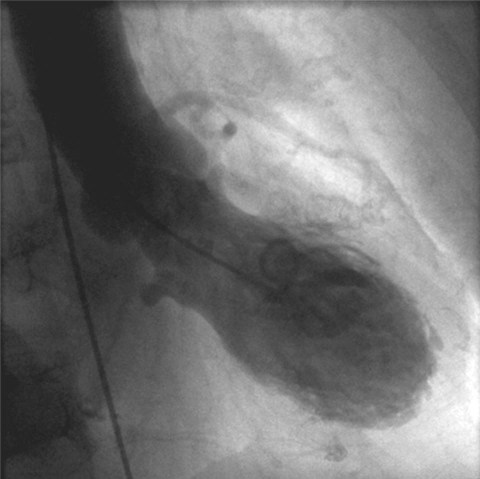Abstract
WEB SITE FEATURE
After 7 days of oral midodrine therapy for symptomatic idiopathic hypotension, a 74-year-old woman presented with angina at a local hospital. Her vital signs were normal, and physical examination revealed nothing unusual. Results of chest radiography, a complete blood count, and a chemistry profile, including cardiac troponin T and creatine kinase, were normal. An electrocardiogram revealed ST-segment elevation of less than 1 mm in leads II, III, and aVF. The patient was given aspirin, intravenous nitroglycerin, and heparin.
Urgent coronary angiography revealed minor luminal irregularities with no evidence of plaque rupture or thrombus. Left ventriculography revealed an estimated ejection fraction of 0.40, akinesis of the mid and distal left ventricle, and normal systolic function of the basal segments (Fig. 1). Troponin T measurement was subsequently positive. The diagnosis of takotsubo cardiomyopathy was made. The patient reported no recent emotional stress or illnesses. Midodrine was suspected as the trigger of the cardiomyopathy because of its a1 agonist properties, and this therapy was discontinued. A transthoracic echocardiogram 2 weeks after the patient's hospital discharge showed complete recovery of left ventricular systolic function.
Fig. 1 Left ventriculogram in end-systole shows akinesis of the mid and distal left ventricle and normal systolic function of the basal segments. Real-time motion image is available at www.texasheart.org/journal.
Comment
To our knowledge, this is the first report of takotsubo cardiomyopathy after midodrine therapy. Important features of takotsubo cardiomyopathy include electrocardiographic findings of minimal ST elevations and mild troponin elevations.1 Our patient's prompt recovery is also consistent with takotsubo cardiomyopathy.2
Emotional stress is the typical trigger of takotsubo cardiomyopathy.2 The pathophysiology is incompletely understood, although hypotheses include a transient sympathetic surge, coronary vasospasm, and ST-elevation myocardial infarction with spontaneous thrombolysis.2 Midodrine, a prodrug metabolized intrahepatically to desglymidodrine, binds a1 receptors to raise arterial blood pressure.3 We surmise that desglymidodrine induced transient coronary vasospasm in our patient, resulting in the symptoms and ventriculographic findings.
Other iatrogenic triggers of takotsubo cardiomyopathy include epinephrine,3 intravenous dobutamine,4 and blood transfusions.5 The underlying mechanism is thought to be transient catecholamine-induced vasospasm. A causal relationship between midodrine and takotsubo cardiomyopathy is not established by our patient's case. Nevertheless, clinicians should recognize this possible adverse effect of oral a agonists in susceptible patients.
Supplementary Material
Footnotes
Address for reprints: Vijay S. Ramanath, MD, Section of Cardiology, Dartmouth-Hitchcock Medical Center, Dartmouth Medical School, 1 Medical Center Dr., Lebanon, NH 03756
E-mail: vijaysr1977@gmail.com
Section Editor: Raymond F. Stainback, MD, Department of Adult Cardiology, Texas Heart Institute at St. Luke's Episcopal Hospital, 6624 Fannin St., Suite 2480, Houston, TX 77030
References
- 1.Kapoor D, Bybee KA. Stress cardiomyopathy syndrome: a contemporary review. Curr Heart Fail Rep 2009;6(4):265–71. [DOI] [PubMed]
- 2.Tsai TT, Nallamothu BK, Prasad A, Saint S, Bates ER. Clinical problem-solving. A change of heart. N Engl J Med 2009; 361(10):1010–6. [DOI] [PubMed]
- 3.Dewachter P, Mouton-Faivre C. Possible link between apical ballooning syndrome during anaphylaxis and inappropriate administration of epinephrine. Mayo Clin Proc 2010;85(4): 396–8. [DOI] [PMC free article] [PubMed]
- 4.Mosley WJ 2nd, Manuchehry A, McEvoy C, Rigolin V. Takotsubo cardiomyopathy induced by dobutamine infusion: a new phenomenon or an old disease with a new name. Echocardiography 2010;27(3):E30–3. [DOI] [PubMed]
- 5.Wever-Pinzon O, Tami L. Takotsubo cardiomyopathy following a blood transfusion. Congest Heart Fail 2010;16(3):129–31. [DOI] [PubMed]
Associated Data
This section collects any data citations, data availability statements, or supplementary materials included in this article.



